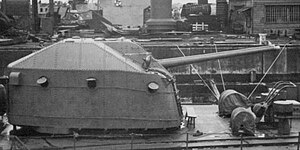10 cm/65 Type 98 naval gun
[dummy-text]
10 cm/65 Type 98 naval gun
| This is an old revision of this page, as edited by Certes(talk | contribs) at 23:43, 25 August 2018 (Fix links to Republic of China (via WP:JWB)). The present address (URL) is a permanent link to this revision, which may differ significantly from the current revision. |
Jump to navigation
Jump to search
 A Type 98 gun mounted on the Japanese destroyer Harutsuki | |
| Type | Naval gun Coast defence gun |
| Place of origin | Japan |
| Service history | |
| Wars | World War II |
| Production history | |
No. built | 169 |
| Specifications | |
| Mass | 3,053 kilograms (6,731 lb) barrel & breech |
Barrel length | 6.73 metres (22.1 ft) bore (65 cal) |
| Shell | 13 kilograms (29 lb) |
| Caliber | 100 millimetres (3.9 in) |
| Elevation | -10° to +90°[1] |
| Rate of fire | 20-22 RPM |
| Muzzle velocity | 1,010 m/s (3,314 ft/s) |
| Effective firing range | Horizontal effective range: 14,000 metres (15,000 yd) Vertical effective ceiling: 11,000 metres (36,000 ft) |
| Maximum firing range | Horizontal:19,500 metres (21,300 yd) Vertical: 13,000 metres (43,000 ft) at 90° |
The 10 cm/65 Type 98 naval gun (六五口径九八式一〇糎高角砲), also known as the long 10cm high-angle gun (長10センチ高角砲), was a light caliber naval gun of the Imperial Japanese Navy used during World War II. It was employed on the aircraft carrier Taihō, the light cruiser Ōyodo, and Akizuki-class destroyers.[1][2] From 1945, land-based installations became more prioritized. The gun was considered by the Japanese to be their finest anti-aircraft artillery weapon. After the end of World War II, the gun remained in service on the two Japanese destroyers ceded to the Soviet Union and the Republic of China as war reparations.
The Allied forces first captured a shore-based twin-mounting of this weapon at Iwo Jima.[3]
Contents
1 Description
1.1 Mountings
1.2 Ammunition
2 Notes
3 References
4 External links
Description
The 100 mm (3.9 in) L/65 caliber Type 98 gun utilized a horizontal sliding breech, in addition to either monobloc (made from a single forging) or replaceable liner construction of the barrel. The gun featured a spring-powered rammer that was cocked by means of the recoil of the gun being fired; this allowed the rammer to load the gun at any elevation. 169 of the guns were completed, with 68 being land-based. Though this oft-quoted number may be outdated, as 116 guns went to ship based mounts, 12 for Taiho and 8 each on Oyodo and the 12 Akizuki-class. One shortcoming of the gun was that it had a service life of only 350-400 effective full charges, as a result of the high muzzle velocity.[1]
Mountings
These guns were used in twin gun turrets. The total weight of the mount and guns on Akizuki was 34,500 kg (76,100 lb). The mount installed on Akizuki could traverse at 12° to 16° per second and could elevate at a rate of 16° per second. It was electro-hydraulically powered and could be moved by hand in the event of an emergency.
Ammunition
The gun fired a 1,118 mm (44.0 in), 28 kg (62 lb), fixed, high-explosive round with a brass casing. Only nose-fused high-explosive ammunition was developed for the gun.
Notes
^ abc Campbell, p. 196
^ Osborne, p. 110-111
^ CINCPAC, p. 38
References
Campbell, John (2002). Naval Weapons of World War Two. London: Conway Maritime Press. ISBN 0-87021-459-4..mw-parser-output cite.citationfont-style:inherit.mw-parser-output .citation qquotes:"""""""'""'".mw-parser-output .citation .cs1-lock-free abackground:url("//upload.wikimedia.org/wikipedia/commons/thumb/6/65/Lock-green.svg/9px-Lock-green.svg.png")no-repeat;background-position:right .1em center.mw-parser-output .citation .cs1-lock-limited a,.mw-parser-output .citation .cs1-lock-registration abackground:url("//upload.wikimedia.org/wikipedia/commons/thumb/d/d6/Lock-gray-alt-2.svg/9px-Lock-gray-alt-2.svg.png")no-repeat;background-position:right .1em center.mw-parser-output .citation .cs1-lock-subscription abackground:url("//upload.wikimedia.org/wikipedia/commons/thumb/a/aa/Lock-red-alt-2.svg/9px-Lock-red-alt-2.svg.png")no-repeat;background-position:right .1em center.mw-parser-output .cs1-subscription,.mw-parser-output .cs1-registrationcolor:#555.mw-parser-output .cs1-subscription span,.mw-parser-output .cs1-registration spanborder-bottom:1px dotted;cursor:help.mw-parser-output .cs1-ws-icon abackground:url("//upload.wikimedia.org/wikipedia/commons/thumb/4/4c/Wikisource-logo.svg/12px-Wikisource-logo.svg.png")no-repeat;background-position:right .1em center.mw-parser-output code.cs1-codecolor:inherit;background:inherit;border:inherit;padding:inherit.mw-parser-output .cs1-hidden-errordisplay:none;font-size:100%.mw-parser-output .cs1-visible-errorfont-size:100%.mw-parser-output .cs1-maintdisplay:none;color:#33aa33;margin-left:0.3em.mw-parser-output .cs1-subscription,.mw-parser-output .cs1-registration,.mw-parser-output .cs1-formatfont-size:95%.mw-parser-output .cs1-kern-left,.mw-parser-output .cs1-kern-wl-leftpadding-left:0.2em.mw-parser-output .cs1-kern-right,.mw-parser-output .cs1-kern-wl-rightpadding-right:0.2em
Osborne, Eric (2005). Destroyers: An Illustrated History of Their Impact. Santa Barbara, CA: ABC-Clio, Inc. ISBN 1-85109-484-9.
CINCPOA, CINCPAC (1945). Japanese Artillery Weapons, CINCPAC-CINCPOA Bulletin 152-45, July 1945. CINCPAC-CINCPOA.
External links
- 10 cm/65 (3.9") Type 98
Categories:
- World War II naval weapons
- Naval guns of Japan
- 100 mm artillery
(window.RLQ=window.RLQ||).push(function()mw.config.set("wgPageParseReport":"limitreport":"cputime":"0.252","walltime":"0.327","ppvisitednodes":"value":1654,"limit":1000000,"ppgeneratednodes":"value":0,"limit":1500000,"postexpandincludesize":"value":31999,"limit":2097152,"templateargumentsize":"value":3072,"limit":2097152,"expansiondepth":"value":8,"limit":40,"expensivefunctioncount":"value":0,"limit":500,"unstrip-depth":"value":0,"limit":20,"unstrip-size":"value":6746,"limit":5000000,"entityaccesscount":"value":0,"limit":400,"timingprofile":["100.00% 279.967 1 -total"," 38.96% 109.085 1 Template:Infobox_weapon"," 35.11% 98.288 1 Template:Infobox"," 27.89% 78.094 3 Template:Cite_book"," 15.29% 42.803 12 Template:Convert"," 12.11% 33.892 2 Template:Nihongo"," 9.03% 25.291 2 Template:Category_handler"," 6.99% 19.578 2 Template:Ship"," 5.60% 15.686 1 Template:WWIIJapaneseNavalWeapons"," 4.12% 11.527 1 Template:Military_navigation"],"scribunto":"limitreport-timeusage":"value":"0.130","limit":"10.000","limitreport-memusage":"value":4915459,"limit":52428800,"cachereport":"origin":"mw1329","timestamp":"20190220213454","ttl":2073600,"transientcontent":false);mw.config.set("wgBackendResponseTime":512,"wgHostname":"mw1329"););

